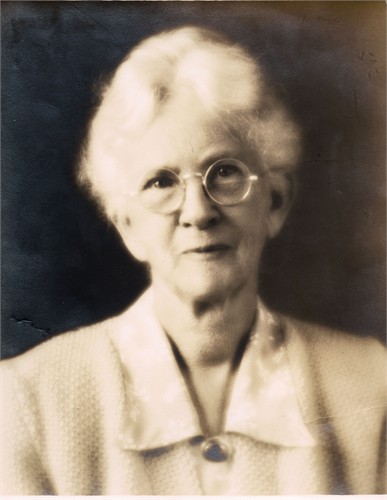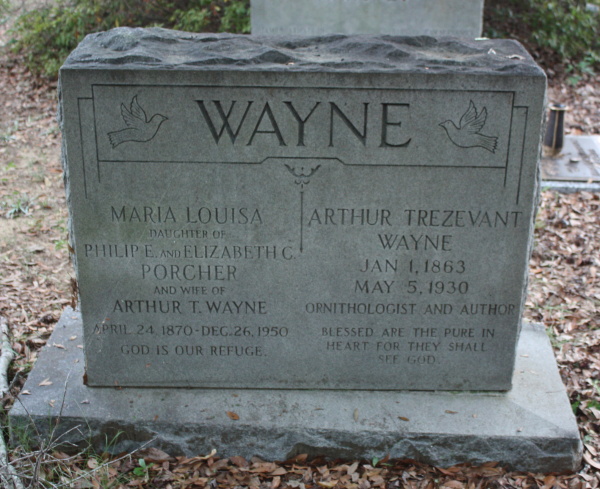ARTHUR TREZEVANT WAYNE & MARIA LOUISA PORCHER WAYNE

Arthur T. Wayne (1863-1930)

Maria Louisa Porcher Wayne

Highway 17, Mt. Pleasant, SC
One of the many memorable characters we talk about on Charleston Raconteurs' French Santee tour is the most accomplished early 20th scientists you've probably never heard of: Arthur T. Wayne, who is buried at Christ Church graveyard. Wayne has been hailed as South Carolina's "premier son of science" and is the author of Birds of South Carolina. The story behind the story, however, is one of the Lowcountry's great love stories.
Arthur Trezevant Wayne was born Jan. 1, 1863, in Blackville, S.C., a small town about 80 miles inland from Charleston, where his mother, Harriet Julia Lavinia Ward Wayne, had sought refuge from the dangers of living in the city during its Civil War bombardment. Harriet was from a distinguished old Colonial family and his father, Daniel G. Wayne Sr., was a successful architect and builder before the war.
The family returned to Charleston after the war, where Arthur attended a private school for several years before entering high school. Though he was a good student, graduating high school in 1880 with honors, some biographers suggest that he had a tendency to allow his attention to wander, and perhaps he did not always take his studies as seriously as he might have, preferring instead to spend as much of his time as possible outdoors, particularly in his pursuit of collecting birds’ nests, eggs and skins.
Some time around 1874, young Wayne began spending a lot of time at The Charleston Museum with its director and curator, Dr. Gabriel Manigault, who encouraged the boy’s interest in natural history. Dr. Manigault introduced Arthur to local taxidermist John Dancer, who taught Arthur how to preserve bird skins. Arthur was enthralled, and by the age of 15, had donated the first of his many bird specimens to the museum.
His family decided that rather than try to pursue higher education or a skilled trade, Arthur was better suited to go into business, and they set about finding him a job. They found him a position with a local company that dealt in cotton and naval stores. In his memorial for The Auk in January 1931, Wayne’s former colleague perhaps summed it up best when he stated: “A short experience with that firm was not of benefit to either of the parties concerned.”
Arthur continued to avidly collect and study birds, even as his parents secured for him a second job in a cotton factor’s office. This job held about as much interest for him as his first had, and he found life in an office suffocating. In 1883, Dr. Manigault introduced Arthur to a visiting ornithologist, William Brewster. Brewster's influence, along with his disdain for office work, sealed Arthur’s fate. He abandoned all pretense of a business career and dedicated all his time to ornithology.
With only a modest education and no affinity for either the trades or business, Arthur’s future could have looked bleak. His parents, however, turned to the last resource they could think of to secure Arthur’s future: a proper wife from a good family of some means.
Arthur married Maria Louisa Porcher of Porcher’s Bluff plantation, just north of Charleston, on June 6, 1889. While living in a small house next to his in-laws, Arthur managed to eke out a humble living collecting, preserving and selling bird skins to other ornithologists. He eventually secured a position at The Charleston Museum as honorary curator, but unfortunately it was an unsalaried position. Yet with the help of his loving, supportive wife, Arthur Wayne spent the rest of his life pursuing his passion for ornithological studies. Maria Louisa spent the rest of her life trying to look out for the health and well-being of her husband, who had a tendency to get so wrapped up in his work he would disappear for hours at a time, sometimes failing to return home until she had rounded up a posse of friends and relatives to go looking for him. It was a perfect match and they shared a happy life together.
Wayne was a frequent contributor to scientific publications around the world, particularly The Auk, the journal of the American Ornithologists’ Union. He was the undisputed authority on South Carolina’s avian species and wrote the definitive manuscript The Birds of South Carolina in 1910.
Soon he was recognized as one of the most knowledgeable ornithologists in the world. Some said his empathy and intuition for birds was so strong that he could often determine their gender without even seeing the evidence necessary to determine it. A skilled taxidermist, his mounted birds are still being displayed in museums around the globe. He also was an early advocate for conservation, many years before the idea became a popular social movement.
Except for a couple of rare trips for research purposes, Arthur Wayne never strayed more than a few miles from his home, even though he was invited to speak at conferences around the world. Nevertheless, he maintained deep, long-lasting friendships with international scientists through letters. Those visiting the Southeast would do their best to make time to drop by Porcher’s Bluff for a visit while they were in the area. Sprunt notes that the silver tray Maria Louisa kept by the door for calling cards read like a virtual Who’s Who of leading scientists of the early 20th century.
Arthur Wayne died of a stroke at Porcher’s Bluff on May 5, 1930, with Maria Louisa by his side. When he was buried at Christ Church, those at his funeral noted that the “birds were chirping in great profusion, a most fitting tribute to a man whose lifetime passion was their study and welfare.”

